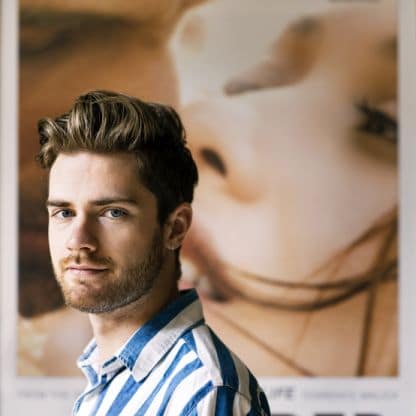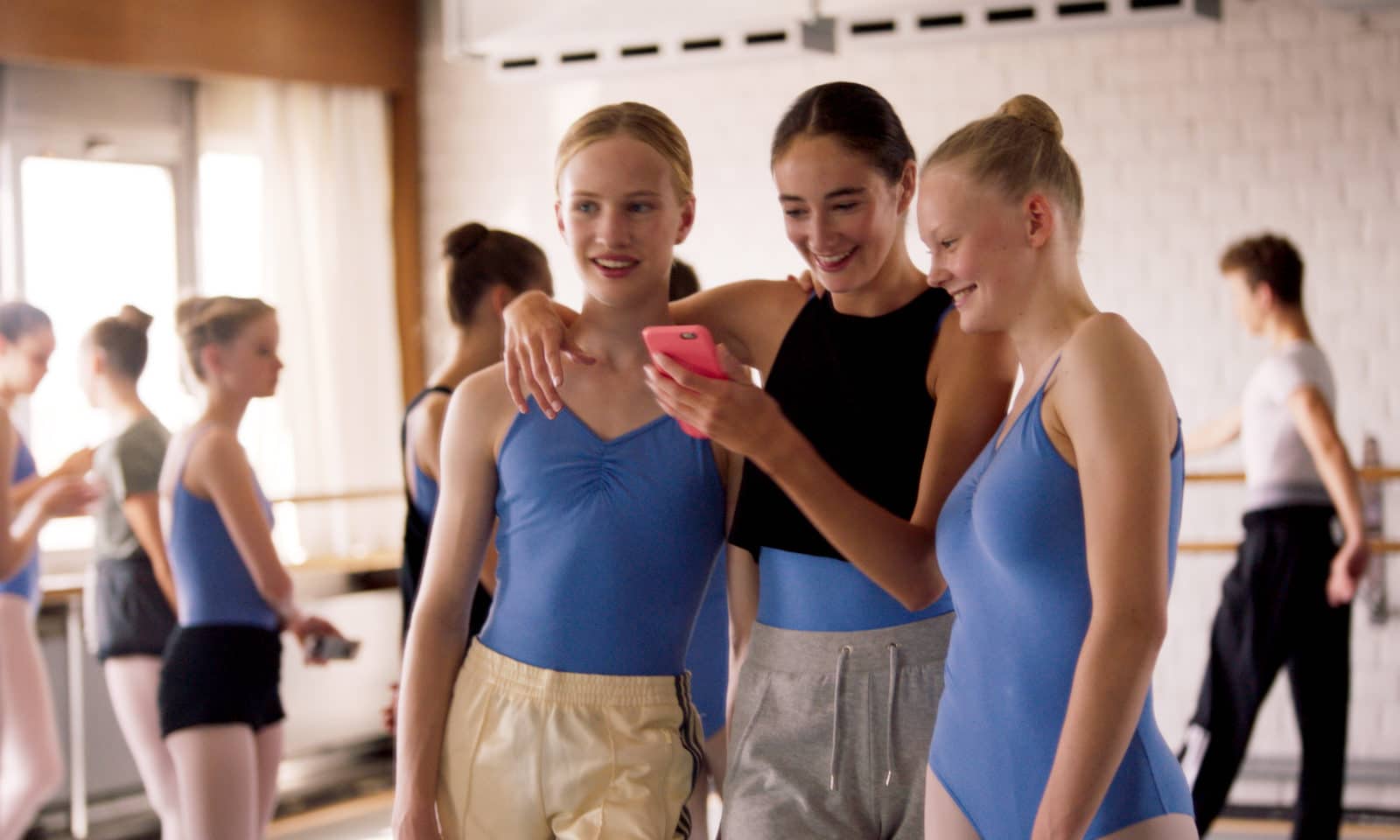Lukas Dhont's father wanted his son to join the scouts. But playing in the mud with other children did not appeal to Lukas. He preferred singing and dancing. He was confused to discover that people saw that as girl stuff. When he was eighteen, and just entering film school in Ghent, he read a newspaper article about a girl born in a boy's body. She wanted to be a ballerina, but was not allowed at school to move from boys' to girls' classes. That theme never left Dhont.
Another nine years later, he Girl made, his first feature-length film, now the Belgian Oscar entry. A film about 15-year-old Lara, who works hard to become a ballerina. And who simultaneously struggles with the boy body she was born into. Girl immediately won prices at Cannes and is on a veritable victory lap, which is all I can call it.
"An intense period," Dhont calls it. Tomorrow, he flies to America. Then to London, because Girl has already received an award there too. Now he is in Amsterdam, to give a series of interviews at Eye Filmmuseum excitedly. From 1 November, Girl in Dutch cinemas. 'A film about gender, identity and perseverance' says the press kit. But it is also a film that manages to bring the unusual subject amazingly recognisable and obvious.
Beyond the coming-out
It is notable that Girl as it were with the door. We see Lara. A teenage girl cuddling with her little brother. We see her with the other girls at her new school. Her practising for ballet. The exciting thing is not that she was a boy, but that she is still a bit wooden. The ballet teacher points out to her that other girls start training as early as 12.
Her coming-out, an obvious dramatic moment, is already behind her. Was that a deliberate choice by Dhont, who also wrote the screenplay (with Angelo Tijssens).

"Yes, it is inspired by the life of an existing girl, but what we have made different is that we have surrounded Lara with people who accept her as she is. The questions her transition raises with her parents or others, that's behind her. We wanted to focus on herself and the internal struggle she faces when she wants to participate in that very classic world of ballet divided into male and female roles."
"Because of her struggle, it inevitably also deals with the very binary-thinking society, without trying to bring it in a dramatising way. It is not a judgmental film. It is a portrait of a young trans girl who wants to become a ballerina and wants to participate in that world."
Bleeding feet
Lara does not spare herself. She smiles dismissively when the psychologist suggests she should enjoy life now after all. She is angry when the doctors refuse to hurry her hormone treatment and surgery. Her skin is sore and distressingly red from the tape she uses to tape her pubic area. Even more telling is the image of her bleeding feet after dance training.
"Of course, the film is very metaphorical. The idea of the pointe, for example, the shoe into which the female dancers have to squeeze their foot. That is a metaphor for a girl who insists on conforming to the ultimate female form, the ballerina. This film is about that moment in our lives when we deny part of our identity to participate in the world that is hetero-cis normative, to this day." [cis is non-trans, LB]
"In our lives, there are stereotypes about men and about women. You can't escape those norms. I myself have struggled immensely with that, with not being able to live up to the stereotype of masculinity. I think it's also why I'm so drawn to this story and why I'm interested in characters like Lara."
An ordinary adolescent girl
Apart from her resisting body, Lara is in almost every way an ordinary adolescent girl. Angry at her father, not because he would find her identity an issue, but simply because he is overprotective. Take also that harsh confrontation with other girls in her class. This would have turned out little differently if Lara had been a misfit for some other reason. In many ways, Lara is a very ordinary girl, and Girl an ordinary, albeit intense and poignant coming-of-age story. The trans theme acts as a kind of magnifying glass.
"Absolutely. Apart from being a trans girl, Lara is also a teenager who, like other teenagers, comes into contact with her own body transforming. Or as in this case, not transforming enough. And that in a world that is super-physical. So yes, it is a coming-of-age film. Lara is a teenager, just like other teenagers."
It is not difficult to identify with her.
"I often hear that, that people really know how to identify with her, which of course I think is a great compliment. We really tried our best to portray someone who is very accessible to a lot of people. Evoking empathy for a character we haven't seen very often, that's perhaps the most important goal of the film."
Quest for the protagonist
This, of course, also has to do with the convincing performance of lead actor Victor Polster, making his debut as an actor here and awarded at Cannes in the Un certain regard section.

"To find someone who could play Lara, we spent a year casting and seeing 500 young people. The problem, of course, was that it is a complex role where very different elements come together. Dancing, acting, Lara's identity. After a year, there was actually no one capable of doing all that."
"Victor we discovered when casting for the other dance roles. He had come to that. He was 14 at the time. An extraordinary talent. It was immediately evident that he was the one we were looking for."
At that time, Victor was already in dance training for classical ballet.
"Only he had never danced on pointes before, men don't do that. To do that for the film, he trained 10 hours a week for three months. With that, his reality came close to Lara's fiction. His feet didn't bleed, but suffered a lot."
"He took on that role with enormous discipline and in a very mature way. A gift to work with that as a director."
Dhont calls working with actors his favourite part of filmmaking.
"Also because it is a study of human beings, a study of how people react, how people move. Every time you direct you learn more about people and also about yourself."
Gender-correct
Victor has made that role his own in a completely natural way, even though he himself is not trans, right?
"He was 14 when I met him. I find it hard to say what he is in his place. Nor is it necessary. The question is a compliment because it shows how truthful he comes across. But it is a performance."
According to some gender-correct opinions, a trans character should also be played by a trans actor.
"I listen to those opinions and find it an interesting dialogue. In the sense that I think trans or gay talent should be much more represented in the industry. And not just in roles or stories based on that part of their identity. In our case, we looked into working with someone who is trans themselves, but found no one. Victor was the one who could play all facets of the role. If we only cast actors who are themselves like the role we would have to adapt a lot."
Dance
Girl is Dhont's first feature-length film. He already touched on similar themes in the three short films he made before this.
“L'Infini was also about the struggle between masculinity and femininity, but in a much more abstract way. In it, a boy faces the return of his father from prison. For the first time, he gets a male influence in his life, having grown up with his mother. In that film, that becomes a kind of dance between a man, a woman and a child. So voilà, in that way, without being autobiographical, I have always worked with it."
Also with dance? You even did a dance performance together with Jan Martens.
"I am a huge admirer of dance. People communicating with their bodies is always special to me. I find it one of the most beautiful art forms and always look for a way to integrate dance into my work. Sometimes very concretely, like with Girl, sometimes more abstract, for example in the choreography of camera movement. Dance is close to my heart."
Girl is attracting attention everywhere and is the Belgian entry for the Oscar for best non-English-language film. Imagine if Dhont, four years out of film school, were already allowed to receive that award. He soberly responds to that suggestion, pointing out that there are many strong titles in contention this year.
"It will be a tough year for that category. Cold War, Roma, there are a lot of good films."
But the shortlist then, perhaps?
"That would already be very nice."
Girl can be seen in Dutch cinemas from 1 November.
